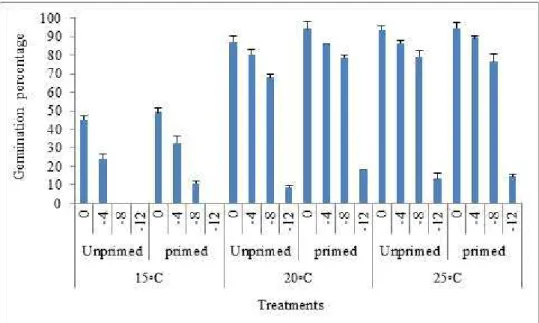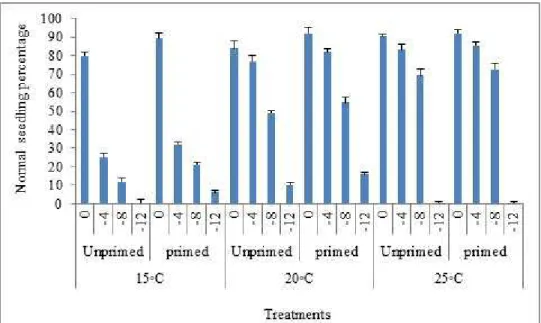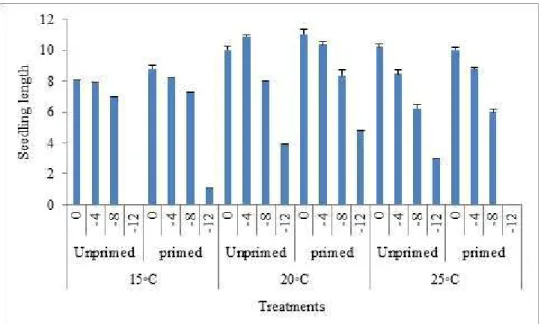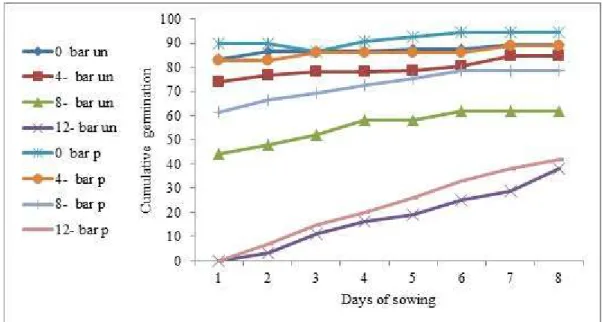Original Text Copyright © 2013 by Azadi, Younesi, Tabatabaei
ORIGINAL ARTICLE
Seed Germination, Seedling Growth and Enzyme Activity of Wheat Seed
Primed under Drought and Different Temperature Conditions
Azadi. M.S.
1, Younesi. E.
2*. Tabatabaei, S. A.
31
Department of Agronomy and Plant Breeding, Islamic Azad University, Dezfoul Branch, Iran.
2 Department of Agronomy and Plant Breeding, Faculty of Agriculture, University of Tehran, Karaj, Iran. 3
Agricultural and natural resources research center of Yazd, Iran
*E-Mail:
younesiehsan@ut.ac.ir
Received July 23, 2013
The study aimed was to determine the effects of drought stress (0, -4, -8, -12 bar) and osmo-priming (-15 bar PEG 6000 for 15 at 24 h) on seed germination, seedling growth and enzyme activity at different temperatures were assessed in the laboratory for wheat. Results showed that the highest germination percentage (GP) (94.33%), normal seedling percentage (NSP) (92%), germination index (GI) (44.85) and seedling length (11.03 cm) were attained from osmo-priming in control conditions. Therefore, seed priming with PEG 6000 significantly (p≤ 0.01) increased germination characteristics as compared to the unprimed seeds under drought stress. Also, osmo-priming increased catalase (CAT) and ascorbate peroxidase (APX) as compared to the unprimed.
ORIGINAL ARTICLE
Seed Germination, Seedling Growth and Enzyme Activity of Wheat Seed
Primed under Drought and Different Temperature Conditions
Azadi. M.S.
1, Younesi. E.
2*. Tabatabaei, S. A.
31
Department of Agronomy and Plant Breeding, Islamic Azad University, Dezfoul Branch, Iran.
2 Department of Agronomy and Plant Breeding, Faculty of Agriculture, University of Tehran, Karaj, Iran. 3
Agricultural and natural resources research center of Yazd, Iran
*E-Mail:
younesiehsan@ut.ac.ir
Received July 23, 2013
The study aimed was to determine the effects of drought stress (0, -4, -8, -12 bar) and osmo-priming (-15 bar PEG 6000 for 15 at 24 h) on seed germination, seedling growth and enzyme activity at different temperatures were assessed in the laboratory for wheat. Results showed that the highest germination percentage (GP) (94.33%), normal seedling percentage (NSP) (92%), germination index (GI) (44.85) and seedling length (11.03 cm) were attained from osmo-priming in control conditions. Therefore, seed priming with PEG 6000 significantly (p≤ 0.01) increased germination characteristics as compared to the unprimed seeds under drought stress. Also, osmo-priming increased catalase (CAT) and ascorbate peroxidase (APX) as compared to the unprimed.
Key words: Wheat, Osmo-priming, Germination characteristics, PEG 6000, enzyme activity
Drought and salinity are widespread problems
around the world (Soltani et al., 2006). Therefore Davidson and Chevalier (1987) and Owen (1972)
reported that seed germination and seedling
growth of wheat (Triticum aestivum L.), like other crops, were negatively affected by drought stress.
Parera and Cantliffe (1994) reported that rapid and
uniform field emergence is an essential prerequisite
to reach the yield potential, quality and ultimately
profit in annual crops.
Seed characteristics are usually essential process
in seedling establishment and plant development to
obtain seedling numbers those results in higher
seed crop (Almansouri et al., 2001; Murungu et al.,
2003). Also, Patade et al. (2011) reported that seed germination and establishment are the most
sensitive stages to salinity stress. Abiotic stresses
maybe delay seed germination and reduce the rate
(Patade et al., 2011; Rouhi et al., 2011; Ansari and Sharif-Zadeh, 2012; Ansari et al., 2012; Ansari et al., 2013). Ashraf and Foolad (2005) showed that seed
priming is one of the methods that can be taken to
counteract the adverse effects of abiotic stresses.
Seed priming techniques have been used to
increase germination, improve germination
uniformity, improve seedling establishment and
stimulate vegetative growth in more field crops
Patade et al., 2011; Foti et al., 2008) under stressed conditions. Also, other researchers reported that,
the priming strategies enhanced activities of free
radical scavenging enzymes such as CAT and APX
(Ansari and Sharif-Zadeh, 2012; Rouhi et al., 2011; Ansari et al., 2013). In addition, the priming increased the germination percentage and activities
of glyoxylate cycle enzymes in Persian Silk Tree
(Albizia julibrissin Durazz) (Sadghi et al, 2011). Therefore, the study aimed was to determine the
effects of drought stress (0, -4, -8, -12 bar) and
osmo-priming (-11 bar PEG 6000 for 15 at 24 h) on
seed germination, seedling growth and enzyme
activity at different temperatures were assessed in
the laboratory for wheat.
MATERIALS AND METHODS
The study was conducted in the seed laboratory
of Natural Resources Faculty, University of Tehran,
Iran.
Drought stress at osmotic potentials of 0 (as
control), - 4, -8 and -12 bar were adjusted using PEG
6000before the start of the experiment.
Seeds of were pretreated with PEG 6000. For
halo-priming, seeds were exposure in -15 bar
concentrations PEG 6000 for 24 h at 15±1°C. Wheat
seeds were exposure in 20 cm glass petri dishes
containing 15 ml solution. The imbibed seeds were
then washed three times with tap water and dried
on filter paper at 15±1°C for 24 h (Ansari and
Sharif-Zadeh, 2012; Ansari et al., 2013).
This experiment was carried out in 4 levels of
dorught stress (0, -4, -8, -12 bar) under different
temperature incubations (15, 20 and 25 °C). For the
germination tests, three replicates of 50 seeds were
surface sterilized and imbibed on two layers of
blotter paper in 9-cm-diameter Petri dishes at 15,
20 and 25 °C incubation under different drought
stress. Germinated seeds were recorded every 24 h
for 8 days. After test time expiration, some
germination indexes were evaluated such as:
Germination percentage, normal seedling
percentage, germination Index and seedling length.
All extraction procedures were carried out at 4
°C. The seed samples, weighting about 0.3 gr, were
homogenized with 3 ml of tris (PH 7.8), followed by
centrifugation of 20000 g for 20 min. The
supernatants were used for determination of
enzyme activity. The supernatants were used for
determination of enzyme activity. Catalase (CAT, EC
1.11.1.6) activity was determined
spectrophotometric ally following H2O2
consumption at 240 nm (Chiu et al., 1995). Ascorbate peroxidase (APX, EC 1.11.1.7) activity
was determined according to the procedures of
Johnson and Cunningham (1972). The activities of
APX and CAT were expressed per mg protein, and
one unit represented 1 μmol of substrate
undergoing reaction per mg protein per min.
All data were analyzed statistically by analysis of
variance usingSAS Software. Data for germination
and normal germination percentages were
subjected to arcsine transformation before analysis
of variance was carried out with SAS software.
Mean comparisons were performed using an
ANOVA protected least significant difference
(Duncan) (P < 0.01) test.
RESULTS AND DISCUSSION
Analyze of variance for osmo-priming showed
that Temperature × Treatment × Drought stress
interaction was significantly (P < 0.01) for all traits
under drought stress (Table 1). Also, our results
showed that the highest germination percentage
(GP) (94.33%), normal seedling percentage (NSP)
length (11.03 cm) were attained from osmo-priming
in control conditions at 20 °C (Fig 1-4).
In agreement with the results, earlier reports
(Ansari et al., 2012; Patade et al., 2011; Ansari et al., 2013), have shown negative affect stress conditions on germination characteristics. The
results of our study suggested that osmo-priming
cause improvement in the seed characteristics as
compared to the unprimed. Cumulative
germination showed that the highest GP at 15 °C,
20 °C and 25 °C was attained from seed primed
under control condition (Fig 6-8).
In agreement with the results, earlier reports
(Ansari et al., 2012; Rouhi et al., 2011; Patade et al., 2011; Ansari et al., 2013) positive effects of priming in relation to seed performance, germination
percentage and seedling indices. In the present
investigation osmo-priming increased catalase and
ascorbat peroxidase as compared to the unprimed
seed (Fig 5). Seed priming highly increased APX and
CAT activities in mountain rye (Ansari et al., 2012; Ansari et al., 2012. Also, Rouhi et al. (2012) showed that antioxidant enzyme activities (superoxide
dismutase, catalase, and peroxidase) in treated
seeds of Berseem clover (Trifolium alexandrinum L.) were significantly increased compared to those in
control group. Oxidative stress blocks growth and
development by decreasing cell division, therefore
protection from oxidative stress is critical for seed
germination. Recent studies show that the presence
of several antioxidative and hydrolytic enzymes in
dry cereal grains, and activities raised considerably
after the start of seed imbibition (Chang et al., 2000; Demeke et al., 2001). Recently ansari and Sharif-Zadeh (2012) in Mountain rye and Rouhi et al. (2012) in Berseem clover (Trifolium alexandrinum L.) showed that antioxidant enzyme activities (superoxide dismutase, catalase, and
peroxidase) in treated seeds of were significantly
increased compared to those in control group.
Table 1. Variance analysis of studied traits in wheat under drought stress.
S.O.V df GP NSP GI LS
Temperature (A) 2 9643.77* * 13367.86* * 5202.23* * 54.32* *
Treatment (B) 1 344.34* * 1505.07* * 24.99* * 6.16* *
Salinity stress (C) 3 8537.25* * 9980.74* * 3586.81* * 55.35* *
A*B 2 70.05* * 331.22* * 3.62n s 0.41* *
A*C 6 296.58* * 1799.99* * 498.8* * 11.01* *
B*C 3 24.25n s 341.08* * 1.48n s 1.41*
A*B*C 6 46.11* * 552.23* * 3.15* * 0.81* *
Error - 12.01 4.31 1.22 0.04
CV - 9.44 8.18 6.17 13.11
*and ** indicate significant difference at 5% and 1% probability level respectively.
Figure 2. Effect of Temperature × Treatment × drought stress interaction on normal seedling percentage.
Figure 4. Effect of Temperature × Treatment × drought stress interaction on seedling length.
Figure 5. Effect of osmo-priming on enzyme activity.
Figure 7. Cumulative seed germination of pre-sowing treated and control of wheat seeds germinated at 20 °C. (un: unprimed, p: primed).
Figure 8. Cumulative seed germination of pre-sowing treated and control of wheat seeds germinated at 25 °C. (un: unprimed, p: primed).
CONCLUSION
The highest germination characteristics were
attained from osmo- priming under control
condition in each temperature. Osmo-priming
increased germination characteristics as compared
to the unprimed seeds. Also, priming increased CAT
and APX. therefore can be said that improvement
this germination characteristics of primed seeds
could be results of increasing the antioxidant profile
of treated seeds.
REFERENCES
Almansouri, M., Kinet, J.M., and Lutts, S. (2001)
Effect of salt and osmotic stresses on
germination in durum wheat (Triticum durum Desf.). Plant and Soil. 231: 243- 254.
Ansari, O., Azadi, M.S., Sharif-Zadeh, F., and
Younesi, E. (2013) Effect of hormone priming
activity of mountain rye (Secale montanum) seeds under drought stress conditions. Journal of Stress Physiology & Biochemistry. 9(3): 61-71.
Ansari, O., and Sharif-Zadeh, F. (2012) Osmo and
hydro priming improvement germination
characteristics and enzyme activity of Mountain
Rye (Secale montanum) seeds under drought
stress. Journal of Stress Physiology & Biochemistry. 8(4): 253- 261.
Ansari, O., Choghazardi, H.R., Sharif Zadeh, F., and
Nazarli, H. (2012) Seed reserve utilization and
seedling growth of treated seeds of mountain
ray (Seecale montanum) as affected by drought stress. Cercetări Agronomice în Moldova. 2 (150): 43- 48.
Ashraf, M., and Bray, C.M. (1993) DNA synthesis in
osmoprimed leek (Allium porrum L.) seeds and evidence for repair and replication. Seed Sci Technol. 3: 15- 23.
Bailey’s Industrial Oil and Fat Products. Interscience
Publishers, New York, pp. 457- 497.
Chang, S., Tan, C., Frankel, E.N., and Barrett, D.M.
(2000) Low-density lipoprotein antioxidant
activity of phenolic compounds and
polyphenoloxidase activity in selected
slingstone peach cultivars. J Agri and Food Chem. 48: 147- 151.
Chiu, K.Y., Wang, C.S., and Sung, J.N. (1995) Lipid
peroxidation scavenging enzymes associated
with accelerated aging and hydration of water
melon seeds differing in ploidy. Plant Physiology. 94: 441- 446.
Davidson, D.J., and Chevalier, P.M. (1987) Influence
of polyethylenglycol induced water deficits on
tiller production in spring wheat. Crop Sci. 27: 1185–1187.
Demeke, T., Chang, H.G., and Morris, C.F. (2001)
Effect of germination, seed abrasion and seed
size on polyphenol oxidase assay activity in
wheat. Plant Breed. 120: 369- 37.
Foti, R., Abureni, K., Tigere, A., Gotosa, J., and
Gerem, J. (2008) The efficacy of different seed
priming osmotica on the establishment of
maize (Zea mays l.) caryopses. J arid Environ.
72: 1127- 1130.
Johnson, L.B., and Cunningham, B.A. (1972)
Peroxidase activity in healthy and
leaf-rustinfected wheat leaves. Phytochemistry. 11: 547– 551.
Murungu, F.S., Nyamugafata, P., Chiduza, C., Clark,
L.J., and Whalley, W.R. (2003) Effects of seed
priming, aggregate size and soil matric
potential on emergence of cotton (Gossypium
hirsutum L.) and maize (Zea mays L). Soil and Tillage Research. 74: 161- 168.
Owen, P.C.J. (1972) The relation of germination of
wheat to water potential. J Exp Bot. 3: 188– 192.
Patade, V.Y., Maya, K., and Zakwan, A. (2011) Seed
priming mediated germination improvement
and tolerance to subsequent exposure to cold
and salt stress in capsicum. Res J Seed Sci. 4 (3): 125 -136.
Parera, C.A., and Cantliffe, D.J. (1994) Pre-sowing
seed priming. Hort Reu. 16: 109– 41.
Rouhi, H.R., Aboutalebian, M.A., Moosavi, S.A.,
Karimi, F.A., Karimi, F., Saman, M., and Samadi,
M. (2012) Change in several antioxidant
enzymes activity of Berseem clover (Trifolium alexandrinum L.) by priming. International Journal of AgriScience. 2(3): 237-243.
Rouhi, H.R., Aboutalebian, M.A., and Sharif-zadeh,
drought stress tolerance during germination in
four grass species. International journal of Agrisience. 1 (2): 107-114.
Sedghi, M., Gholipouri, A., and Seyed Sharifi, R.
(2008) γ-Tocopherol accumulation and floral
differentiation of medicinal pumpkin (Cucurbita
pepo L.) in response to plant growth regulators.
Not Bot Hort Agrobot Cluj. 36: 80- 84.
Soltani, A., Gholipoor , M., and Zeinali, E. (2006)
Seed reserve utilization and seedling growth of
wheat as affected by drought and salinity.



